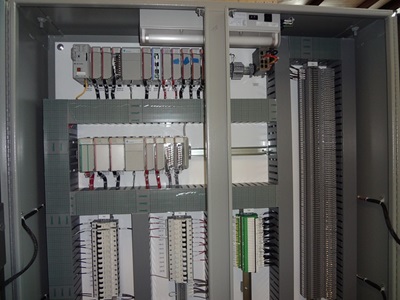
Basic Concepts
Protection coordination in simple terms may be understood as relay trip time coordination. When some fault occurs in low voltage side say 33kv , we need a system to ensure that fault should get cleared in 33kv side only without causing any disturbance in higher voltage level- 132kv, 220kv etc. Also the transmission lines should not trip due to a fault in the transformer in a substation , therefore the relay timing in the transformer is kept lower than that of lines. Similarly a fault occurring in 132kv should be cleared at this level and should not be cleared at higher voltage levels.
Therefore low voltage side time setting in relays is kept at lower values and tms (time multiplier setting) is increased while moving from lower to higher voltage level .
Let us understand typical time coordination in a 132/33kv substation :
For 33kv feeders tms is usually set at 50 ms (milli-seconds)
For 33kv side (LV) side of transformer tms can be kept at 80ms
For 132kv side(HV) side of transformer tms can be kept at 100/125 ms
For 132kv lines ,tms can be kept at 150 ms.
Thus protection coordination involves configuring protection devices so that they work together seamlessly to isolate a fault. This ensures that only the faulty section of the system is disconnected, preventing widespread outages and equipment damage.
Key Elements Involved
Key elements in protection coordination include time-current characteristics, device(relay) settings, and system configuration. Proper coordination ensures that the device closest to the fault operates first, while upstream devices provide backup protection means they will trip only when fault at lower voltage level is not cleared due to some reason.
Types of Protection Devices
Fuses
Fuses are simple protective devices that melt when the current exceeds a certain threshold, breaking the circuit. They are widely used due to their simplicity and reliability. They are not used at higher voltage levels.
Circuit Breakers
Circuit breakers with help of relays automatically interrupt the flow of current when a fault is detected. The relays can be reset after tripping, making them reusable and convenient for various applications.
Relays
Relays are electrically operated switches used in conjunction with circuit breakers. They detect abnormal conditions (faults) and send signals to the circuit breakers to trip and isolate the fault.
The Need for Protection Coordination
Preventing Equipment Damage
Effective protection coordination ensures that fault occurring in the devices closest to the fault operates first, while upstream devices provide backup protection.Also it prevents equipment from being exposed to excessive currents, which can cause severe damage and reduce their lifespan.
Ensuring Safety
Properly coordinated protection devices ensure the safety of personnel by quickly isolating faulted sections and preventing dangerous conditions.
Minimizing Downtime
We don’t want a generating station to trip due to fault of 11kv feeder emanating from a downstream 33/11kv substation. A fault occurring at 11kv should get cleared at this level itself , thus by isolating only the affected parts of the system, protection coordination minimizes downtime and helps maintain continuous operation.
Steps Involved in Protection Coordination Studies
Data Collection
Gathering accurate system, load, and equipment data is the first step in conducting protection coordination studies.
System Modeling
Using software tools, engineers create detailed models of the electrical system to simulate different scenarios and analyze protection performance.
Fault Analysis
Engineers perform fault analysis to determine the types and magnitudes of faults that the system may experience, which is crucial for selecting appropriate protection devices.
Protection Device Selection
Selecting the right protection devices involves considering various criteria, including system requirements, device ratings, and manufacturer specifications.
Coordination Analysis
Coordination analysis involves comparing the time-current characteristic curves of different devices to ensure they operate in the correct sequence.
Data Collection for Protection Coordination
System Data
Collecting system data includes information on power sources, transformers, transmission lines, and distribution networks.
Load Data
Load data involves understanding the demand characteristics, including peak loads, load profiles, and future load growth projections.
Equipment Ratings
Equipment ratings such as voltage, current, and interrupting capacity are essential for selecting appropriate protection devices.
System Modeling Techniques
Software Tools
Software tools like ETAP, DIgSILENT, and PSS/E are commonly used for creating detailed models of electrical systems and performing simulations.
Simulation Methods
Simulation methods include steady-state and dynamic simulations, which help in understanding the system’s behavior under different conditions.
Fault Analysis Procedures
Types of Faults
Common types of faults include short circuits, ground faults, and phase-to-phase faults. Each type affects the system differently and requires specific analysis.
Calculating Fault Currents
Calculating fault currents involves determining the magnitude of current during a fault condition, which is critical for setting protection device parameters.
Impact of Faults on the System
Faults can cause voltage drops, equipment damage, and system instability. Understanding their impact helps in designing effective protection schemes.
Selecting Protection Devices
Criteria for Selection
Criteria for selecting protection devices include system voltage, current ratings, fault current levels, and coordination requirements.
Matching Devices with System Requirements
Protection devices must be matched with system requirements to ensure they operate effectively during fault conditions.
Coordination Analysis
Time-Current Characteristic Curves
Time-current characteristic (TCC) curves show the relationship between operating time and current magnitude for protection devices.
Coordination Charts
Coordination charts help in visualizing the coordination between different protection devices, ensuring they operate in the desired sequence.
Adjusting Settings for Optimal Coordination
Adjusting device settings involves fine-tuning parameters to achieve optimal coordination and prevent nuisance tripping.
Challenges in Protection Coordination
Complex Systems
Complex electrical systems with multiple interconnections and varying load conditions pose significant challenges for protection coordination.
Evolving Standards
Protection coordination standards and practices evolve over time, requiring continuous updates and adaptations to new guidelines.
Inter-device Compatibility
Ensuring compatibility between protection devices from different manufacturers can be challenging, requiring careful selection and testing.